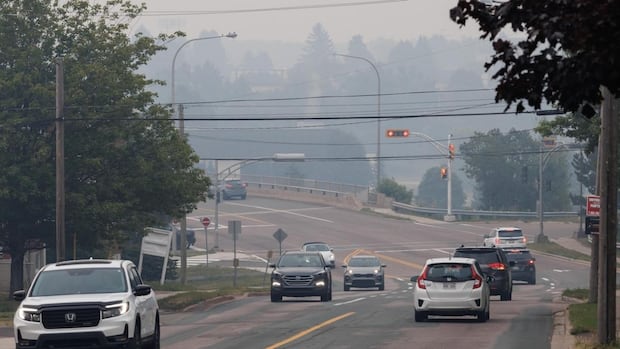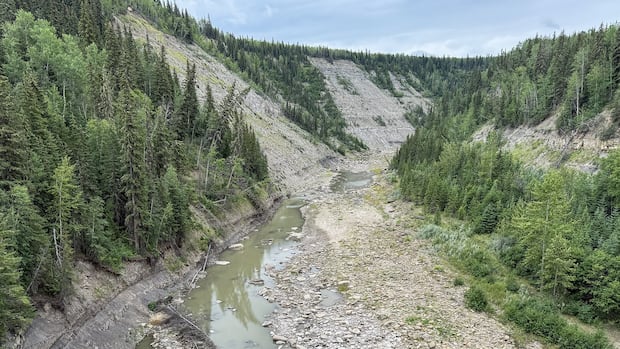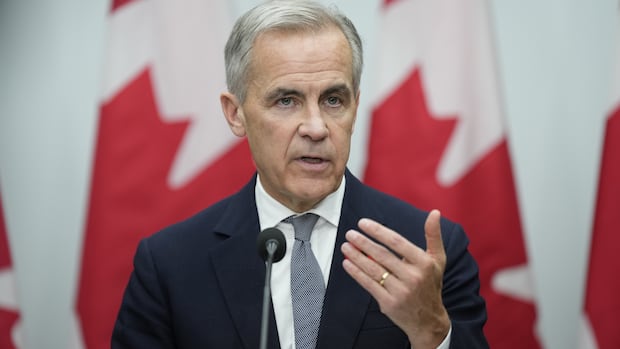Smoky conditions had some people in southeastern New Brunswick and the Saint John area thinking a wildfire was on their doorstep.
But CBC meteorologist Tina Simpkin says the source of the smoke Monday was actually quite a distance away in Nova Scotia.
“A very unique weather setup” allowed it to happen, Simpkin said.
“This summer has been unusual. We’ve had ridges of high pressure that sit overhead.”
Normally, hot, smoky air rises to cooler, higher atmosphere, she said.
But in recent days, a ridge of high pressure caused relatively warm conditions in the upper atmosphere, which held the smoke low to the ground.
“Once the smoke hits that kind of cap, it kind of pools there,” Simpkin said.
Meanwhile, west-southwest wind pushed the smoke along into parts of New Brunswick and P.E.I.
These conditions happen from time to time, said Simpkin, and when combined with a forest fire, the effects are pronounced.
“This is becoming our new normal,” she said.
“This is part of global warming. We’re going to have to start preparing and taking a look at these kinds of issues in the years to come.”
New Brunswick’s chief medical officer of health says wildfire smoke can be harmful for the very young, very old, pregnant women and those with underlying heart or lung conditions.
Wildfire smoke poses an increased health risk for many people, said Melanie Langille of NB Lung.
It can be enough to trigger shortness of breath or difficulty breathing — a life-threatening situation, Langille said.
Those most at risk from smoke pollution include older adults, children, people who are pregnant or who have heart or lung conditions, diabetes, cancer, or mental health conditions, and those who work outdoors, she said.
NB Lung has a network of about two dozen air quality sensors located at homes and businesses around the province, said Langille, and air quality can change daily.
Typically, New Brunswick’s air quality health index scores one to three on a scale of one to 10, said Langille.
“The areas that were impacted by smoke yesterday were registering at a seven,” she said.
App can help
Langille advises anyone concerned about air-quality health risks to download the WeatherCan app and set alerts at the air quality health index level of their choosing.
“I have really mild asthma. I notice a difference — an increase in my symptoms when the AQHI is at three. So my alerts are set for when the forecast is going to be three.”

The index is really helpful, said Langille.
On days when air quality is poor, it’s a good idea to reduce the intensity of anything you do outdoors, she said.
The air quality health index looks at things such as ozone, nitrogen dioxide and fine particulate matter, said Simpkin.
These are particles smaller than the width of a human hair. They can reduce visibility and cause health effects.
Fine particulate matter is what mainly irritates the lungs, said Langille. It can penetrate into the blood and irritate other internal systems as well.
Drinking plenty of water can help the body flush it out, she said.
Consider a mask
Another measure to mitigate health risks from smoke is wearing a mask, she said.
Masks can be helpful during episodes of poor air quality, agreed Dr. Yves Léger, New Brunswick’s chief medical officer of health.
He stipulated that they should be certified N95 or equivalent, in order to filter out very fine particulates. Dust masks from hardware stores are insufficient, he said.
Fit is also important. The mask has to fit snugly against your skin to create a seal, Léger said.
The public health doctor also noted that masks cannot reduce exposure to other pollutants in wildfire smoke.
“You still have to take precautions,” he said.
If the air quality even inside your home is bad, Léger recommended not staying there and suggested going to a neighbour’s, a mall or a library.
On Tuesday, Simpkin forecast that a more westerly wind would keep smoke away from New Brunswick.
There could still be “some leftover pockets of smoke,” however, in low-lying areas, she said.
“It’s going to take a while to really clear it out,” she said.
Simpkin noted a couple of other good resources to track smoke and air quality are firesmoke.ca and the Canadian Wildfire Information system.








